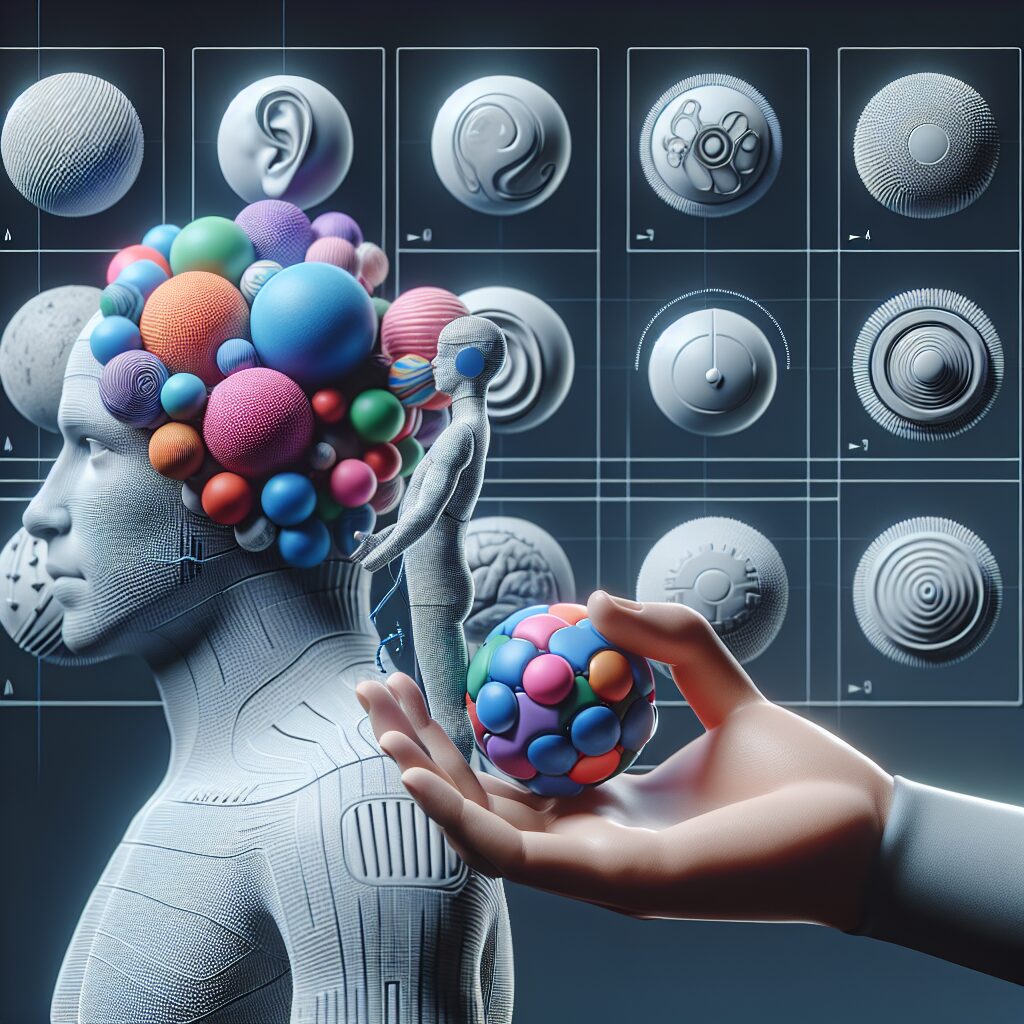Sensory disorders are a complex set of conditions that can greatly impact an individual’s daily life. These disorders, which include sensory processing disorder (SPD), autism spectrum disorder (ASD), and attention deficit hyperactivity disorder (ADHD), affect how individuals receive and interpret sensory information from their environment. This can result in over-sensitivity or under-sensitivity to certain stimuli, leading to difficulties in social interaction, communication, and behavior.
One unique feature of sensory disorders is their diverse range of symptoms and severity levels. While some individuals may only be mildly affected, others may experience significant challenges in managing their sensory sensitivities. For example, a person with SPD may be easily overwhelmed by loud noises while someone with ASD may struggle with social interactions due to heightened sensory experiences. In order to address these challenges, individuals with sensory disorders often require tailored approaches to therapy and intervention.
Moving forward, this article will explore the concept of ball therapy as a potential solution for individuals with sensory disorders. A promising and increasingly popular therapeutic technique, ball therapy aims to provide sensory input and promote the development of various motor skills through the use of different types of balls. By engaging in targeted ball exercises, individuals with sensory disorders can improve their sensory processing abilities, coordination, and emotional regulation. In the following sections, we will delve into the key takeaways of this therapy, including its benefits, techniques, and considerations for implementation.
Key Takeaways
1. Sensory disorders can be effectively treated using a tailored approach, particularly through ball therapy. This approach helps individuals with sensory processing issues to improve their motor skills, coordination, sensory integration, and overall well-being.
2. Ball therapy involves the use of various types of balls to stimulate specific sensory systems and target the unique needs of each individual. Activities include rolling, bouncing, tossing, and catching balls, which not only engage the senses but also help with balance, body awareness, and attention.
3. Sensory integration is a crucial aspect of ball therapy as it helps individuals with sensory disorders to process and respond to sensory information more effectively. By engaging in ball exercises, individuals can enhance their ability to organize and interpret the input from their senses, leading to improved overall performance and functioning.
4. Ball therapy can benefit children and adults with various sensory disorders, including but not limited to autism spectrum disorder, attention deficit hyperactivity disorder (ADHD), and developmental coordination disorder (DCD). The versatility of ball therapy allows it to be adapted to the specific needs and abilities of each individual, making it an inclusive and useful intervention.
5. The effectiveness of ball therapy lies in its ability to provide a dynamic and engaging environment that promotes learning, exploration, and the development of essential skills such as hand-eye coordination, bilateral coordination, and spatial awareness. This therapeutic approach offers a holistic and enjoyable way to address sensory issues and improve overall sensory processing abilities.
Can Ball Therapy Offer a Tailored Approach for Sensory Disorders?
The Importance of Sensory Disorders
Sensory disorders, such as autism spectrum disorder (ASD) or attention deficit hyperactivity disorder (ADHD), affect millions of individuals worldwide. These conditions can significantly hinder daily functioning, making it crucial to find effective therapeutic interventions. One promising approach gaining recognition is ball therapy.
Understanding Sensory Disorders
Sensory disorders occur when an individual’s sensory system is either over- or under-responsive to environmental stimuli. This can lead to challenges with sensory processing, affecting various aspects of a person’s life, including communication, attention, and behavior.
The Role of Ball Therapy
Ball therapy, also known as therapeutic ball therapy or sensory ball therapy, is a specialized treatment technique that utilizes sensory-rich balls to address the unique needs of individuals with sensory disorders. This therapy aims to regulate sensory input, promote self-regulation, and improve overall functioning.
Benefits of Ball Therapy for Sensory Disorders
1. Sensory Stimulation: The use of sensory balls provides diverse tactile, proprioceptive, and vestibular input, stimulating the senses and aiding sensory integration. This can enhance sensory perception and integration skills.
2. Motor Skills Development: Ball therapy involves engaging in different activities, such as throwing, catching, or bouncing balls. These activities promote the development of fine and gross motor skills, coordination, and balance.
3. Calming and Focus: The repetitive, rhythmic movements involved in ball therapy can have a calming effect on individuals with sensory disorders. This can improve attention, focus, and reduce anxiety levels.
4. Social Interaction: Ball therapy sessions often incorporate group activities, fostering social interaction, cooperation, and improved communication skills among individuals with sensory disorders.
Implementing Ball Therapy
When considering ball therapy as a tailored approach for sensory disorders, it is essential to collaborate with qualified professionals, such as occupational therapists or sensory integration specialists. They can design personalized therapy plans based on individual needs, utilizing a variety of balls and therapeutic techniques.
Tips for Implementing Ball Therapy:
- Consult with an experienced professional to assess the specific sensory needs and goals of the individual.
- Select appropriate sensory balls that offer different textures, sizes, and weights to cater to diverse sensory preferences and challenges.
- Design therapy sessions that incorporate a variety of engaging activities like rolling, tossing, or squeezing the balls.
- Gradually increase the complexity of activities to continually challenge and stimulate sensory integration.
- Regularly monitor progress and modify therapy plans as needed, ensuring a tailored approach.
Frequently Asked Questions
1. What are sensory disorders?
Sensory disorders refer to conditions that affect the way a person processes sensory information. This can involve difficulties with sensory integration, causing individuals to over- or under-react to certain stimuli.
2. What is ball therapy?
Ball therapy, also known as sensory ball therapy, is a method used to provide sensory stimulation and improve sensory integration. It involves the use of different types of balls, such as therapy balls or inflatable exercise balls, to engage various senses and promote therapeutic benefits.
3. How does ball therapy benefit individuals with sensory disorders?
Ball therapy can help individuals with sensory disorders by providing sensory input and stimulation, which can help them regulate and manage their responses to sensory stimuli. It can improve body awareness, coordination, balance, and confidence, while also promoting relaxation and reducing anxiety.
4. Who can benefit from ball therapy?
Ball therapy can benefit individuals of all ages who experience sensory processing difficulties or sensory disorders. This includes individuals with autism spectrum disorder, attention deficit hyperactivity disorder (ADHD), sensory processing disorder, and other related conditions.
5. What types of ball therapy exercises can be done?
There are various types of ball therapy exercises that can be done, depending on the individual’s needs and goals. These may include bouncing on a therapy ball, rolling a therapy ball on the body, playing catch with a partner, or performing specific movements while seated on a therapy ball.
6. Can ball therapy be done at home?
Yes, ball therapy can be done at home with proper guidance and supervision. It may be beneficial to consult with a qualified occupational therapist or healthcare professional who can provide recommendations and suggestions for specific exercises and techniques.
7. Are there any risks or precautions associated with ball therapy?
While ball therapy is generally safe, it’s important to take certain precautions. Ensure that the ball is properly inflated and stable to prevent falls or injuries. Individuals with certain medical conditions or injuries should consult with their healthcare provider before engaging in ball therapy.
8. How often should ball therapy sessions be done?
The frequency of ball therapy sessions will vary depending on the individual’s needs and recommendations from a healthcare professional. It may be done as part of a regular therapy program or as a home-based exercise regimen. Consistency and regularity are key for optimal benefits.
9. Can ball therapy be combined with other therapeutic approaches?
Yes, ball therapy can be combined with other therapeutic approaches to create a comprehensive treatment plan. It can complement occupational therapy, physical therapy, and other interventions aimed at addressing sensory processing difficulties and improving overall functioning.
10. Where can I find resources or additional information about ball therapy and sensory disorders?
There are several resources available that provide information, exercises, and guidance on ball therapy and sensory disorders. These include books, websites, and professional organizations specializing in occupational therapy or sensory integration therapy.
Final Thoughts
Overall, sensory disorders and ball therapy offer a tailored approach to address the unique challenges faced by individuals with sensory processing difficulties. By incorporating ball therapy exercises into treatment plans, these individuals can experience improvements in sensory integration, coordination, and overall well-being. The versatility and accessibility of ball therapy make it a valuable tool for both professionals and individuals looking to manage sensory disorders effectively.
However, it is important to remember that ball therapy should always be conducted under the guidance of a qualified professional. They can provide necessary modifications, safety precautions, and personalized exercises to ensure the therapy is both effective and appropriate for the individual’s needs. With the right approach and support, individuals with sensory disorders can benefit greatly from ball therapy and enhance their overall quality of life.




